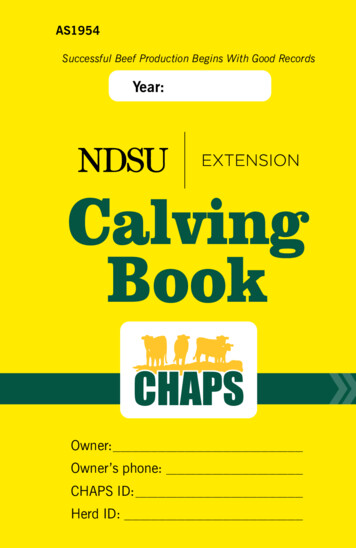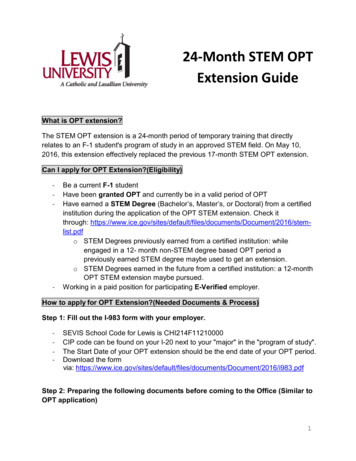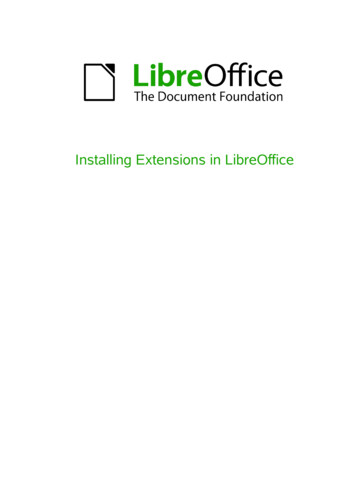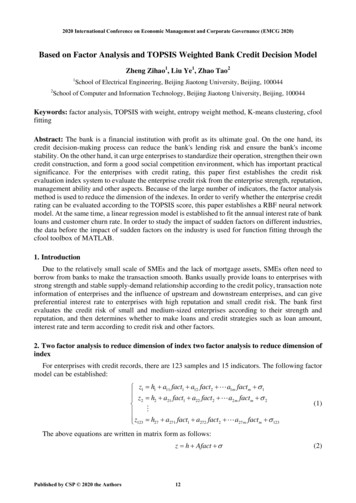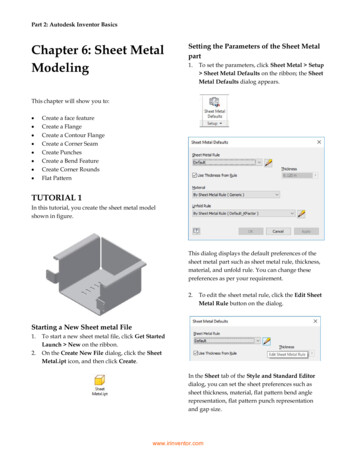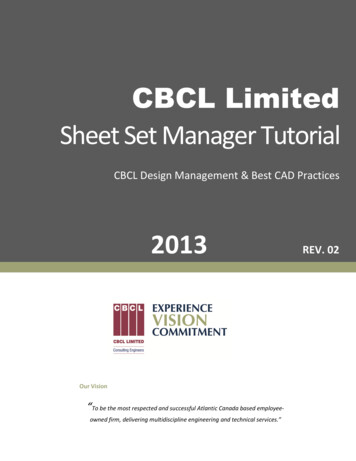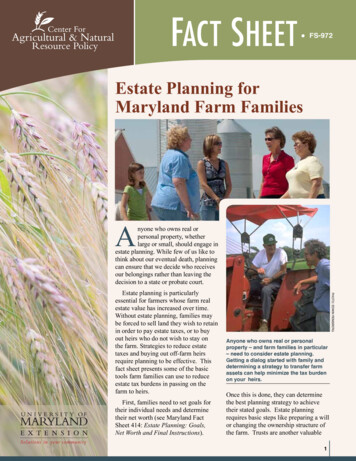
Transcription
FACT SHEET FS-972Estate Planning forMaryland Farm FamiliesAnyone who owns real orpersonal property, whetherlarge or small, should engage inestate planning. While few of us like tothink about our eventual death, planningcan ensure that we decide who receivesour belongings rather than leaving thedecision to a state or probate court.First, families need to set goals fortheir individual needs and determinetheir net worth (see Maryland FactSheet 414: Estate Planning: Goals,Net Worth and Final Instructions).PHOTO: Edwin remsbergEstate planning is particularlyessential for farmers whose farm realestate value has increased over time.Without estate planning, families maybe forced to sell land they wish to retainin order to pay estate taxes, or to buyout heirs who do not wish to stay onthe farm. Strategies to reduce estatetaxes and buying out off-farm heirsrequire planning to be effective. Thisfact sheet presents some of the basictools farm families can use to reduceestate tax burdens in passing on thefarm to heirs.Anyone who owns real or personalproperty – and farm families in particular– need to consider estate planning.Getting a dialog started with family anddetermining a strategy to transfer farmassets can help minimize the tax burdenon your heirs.Once this is done, they can determinethe best planning strategy to achievetheir stated goals. Estate planningrequires basic steps like preparing a willor changing the ownership structure ofthe farm. Trusts are another valuable1
CANRP FS-972 April 2014While this fact sheet presentssome tools to consider in yourestate planning, each individual’sand family’s circumstances will bedifferent. You should seek the adviceof a tax attorney, accountant, orfinancial advisor. The information inthis fact sheet should prepare you fora fruitful session with these advisors.Determining Your Net WorthKnowing what amount can beexempted from the estate beforetaxation is only useful if you knowthe fair market value of your grossestate. You need to sit down, list yourassets and liabilities, and figure outyour net worth. You may be surprisedby how much your net worth actuallyis, especially if your land or businesshas not been appraised recently. Networth equals assets minus liabilities.Assets include your land, buildings,livestock, equipment, personalresidence, cars, other personalproperty, savings, stocks and bonds,pensions, or other retirement savings.Assets can also include the value ofany life insurance policies you own.Liabilities are any outstanding debtsyou owe on these items, such asmortgages, other loans, and policy2PHOTO: Edwin remsbergplanning technique. Some farmfamilies may look at selling ordonating an easement as an estateplanning tool. Others may findtransferring the farm before thedeath of the owner(s) works best fortheir situation and can do so eitherthrough a sale or as a gift. Anothermechanism to overcome some of theproblems of being land rich and cashpoor is to invest in a life insurancepolicy. Particular provisionsapplicable to farm families, includingthe Special Use Valuation provisionsand options for estate tax payments,will also be discussed.You may be surprised by what your net worth actually is, especially if your landor farm business has not been appraised recently. Without estate planning,families may be forced to sell land whose worth has appreciated in order to payestate taxes, or buy out heirs who do not wish to farm.premiums. For more information oncalculating net worth, see Universityof Maryland Extension FactSheet Number 540 and Fact SheetNumber 414.If your personal net worth in 2014is near or above 5,340,000 (or as acouple 10,680,000), you will wantto do planning to minimize yourestate taxes. Even if your estate fallsbelow the exempted amount, estateplanning can facilitate the transferof your property and ensure thecontinuation of the family business.In addition, Maryland has recentlyrecoupled their estate tax exemptionsto the federal exemption but this willbe phased in over the next 5 years.In 2014, Maryland exempts only thefirst 1 million per person for nonagricultural property and the first 5million per person for agriculturalproperty; planning may help avoidstate estate tax even if you will oweno federal tax. By 2019, Marylandwill exempt up to the federalexemption level. Furthermore,talking with your heirs now canavoid potential disagreements anddisputes following your death.Stating your wishes now will helpyour heirs make decisions now andafter you have gone.Federal Estate TaxesFederal estate taxes are leviedon a deceased individual’s taxableestate. The taxable estate is the grossestate minus allowable expenses anddeductions. The gross estate refersto the assets owned by the deceasedindividual, plus the value of allunderlying properties for retained lifeestates and any other assets under thedeceased’s control. An example ofa gross estate for a farmer is shownin table 1. While land and buildingsare the largest asset amount, valuedat 4.5 million, other assets on thefarm, personal life insurance, and abank balance add up to a total estateworth more than 5 million.Allowable expenses anddeductions to the gross estate include
CANRP FS-972 April 2014funeral expenses, estate administrative expenses, giftsto spouse, debts owed by the deceased, Maryland estateand inheritance taxes, and charitable gifts. See table 2for an example of these expenses and deductions. Forthis example, the total of these expenses and deductionsis 145,000. This amount is subtracted from the grossestate, resulting in a taxable estate of 5.555 million.Federal estate taxes are calculated on this amount.The federal estate tax rate is now a flat rate at 40%for amounts above the exempted amounts in 2013and forward. Unlike in previous years, the rates andexemption are permanent with no expiration date, andwill only change if Congress changes them. This lifetimeexemption is pegged to inflation and will increase eachyear after 2013.For the farm example with a taxable estate of 5.555million, only the amount above the 5.34 million lifetimeexemption is subject to tax payments in 2014. Thereforethe taxable estate equals 215,000. Given the 40% taxrate, the estate will owe 86,000 (215,000 x 40%) withinnine months of death.For example, Jim and Mary own a farm worth 11million. Jim dies in 2012 and his half of the farm ( 5.5million) is passed to Mary through the unlimited spousalexemption. Mary files an estate tax return claiming theunused portion of Jim’s exclusion amount ( 5.12 million).Example of Farm Gross EstateAssetsLand and BuildingsValue 4,500,000Machinery 240,000Livestock 500,000Crop Inventory 65,000Feed and Supplies 20,000Life Insurance 300,000Bank Balance 75,000Total 5,700,000Table 2. Example of Allowable Expenses andDeductions for a Farm EstateFuneral Expenses 10,000Legal Fees 15,000Donation to Church 50,000Bank Loan 60,000Feed Store Account 10,000Total 145,000PHOTO: Edwin remsbergMarried couples should take into account the unlimitedmarital deduction that exists in federal estate taxes.Following the death of the first spouse, his or her half ofthe estate can be transferred to the surviving spouse taxfree, regardless of the value of the first spouse’s estate.Since 2011, the surviving spouse may add the unusedportion of the predeceased spouse’s applicable exclusionamount to his or her own. This is known as portabilityand is now a permanent feature of federal estate and gifttax law. The applicable exclusion amount acquired froma deceased spouse (provided that the surviving spousedoes not remarry) may be used to offset either the taxon lifetime gifts or transfers upon death. This is notautomatic, however. The unused portion of the deceasedspouse’s federal estate tax exemption must be preservedfor the surviving spouse to use. To preserve the unusedportion, the deceased spouse’s remaining applicableexclusion amount is taken on a timely filed (includingextensions) estate tax return (Form 706) upon whichthe remaining exclusion amount is calculated, and astatement is included on the face of the return being takenby the surviving spouse.Table 1.Following the death of the first spouse, his or her halfof the estate can be transferred to the surviving spousetaxfree, regardless of the value of the first spouse’s estate.3
CANRP FS-972 April 2014PHOTO: Edwin remsbergwill not be covered in this factsheet.Nor will durable powers of attorney,health care proxies, and living willsbe addressed. These three toolsdo not involve how to distribute aperson’s property but how to makehealth and business decisions if theperson is no longer able to makethose decisions. Durable powersof attorney and health care proxiesappoint a representative or agentfor a person in the event the personbecomes incapacitated. A livingwill specifies the type of medicaltreatments the person would like toreceive or forego.Mary passes away in 2014. Maryand Jim’s kids would inherit 10.37million of the farm estate tax- free,because Jim had 5.12 million ofunused federal estate tax exclusionsin 2012 that was portable to Mary.Mary also has a 5.34 million federalestate tax exclusion in 2014. Jim andMary’s kids would owe federal estatetaxes of 216,000 or ( 540,000 x40%) on the remaining 540,000 ofthe estate.Estate Planning ToolsWhen people think of estateplanning, they typically think ofhaving a will. Their estate plan,however, will be more than just awill. A will is only a document whichdirects how a person’s propertyand assets should be distributedupon death. The tools used in theestate planning process will reflectthe individual’s goals on not onlydistributing their property and assets,but contain plans for continuingthe family farm and placing theproper family members in chargeof business and health decisionsthat could arise if the individualbecomes incapacitated.4The common tools usedin the estate planningprocess include: Business entities, such asa limited liability company(LLC), partnership, orcorporation Gifts Will Titling of property Trusts Life Insurance Durable Power of Attorney,Health Care Proxy, andLiving Wills Retirement planningAn estate plan will use somecombination of these tools becauseeach person will have differentgoals that need to be met in theprocess. While retirement planning isimportant as a tool for ensuring thatthere is sufficient family income tofinance intergenerational transfers, itFor example, Bill runs a farmingoperation, his adult son Tomworks for him, and Bill’s wife haspredeceased Bill. One day whileworking on the farm, Bill is severelyinjured and falls into a coma. If Billhas a durable power of attorneynaming Tom as his agent, then Tomwill be able to step into Bill’s shoesin the farming operation and makedecisions as if he is Bill. If Bill hasnamed Tom as his health care proxy,then Tom would be able to step inand make those medical decisionsnecessary to keep his dad alive.Finally, with a living will Bill wouldbe able to specify the medical carehe would like to receive or not. Billmay have decided to forgo the useof a ventilator or respirator in certainsituations, for example.Setting GoalsThe first step of estate planningis setting goals for your businessand your personal life, includingyour property and income. Propertyincludes both real property andpersonal property. Real propertyincludes your land, house, farmstructures, and all real estateimprovements. Personal property
CANRP FS-972 April 2014According to the 2012 Censusof Agriculture, around 83% ofall farms in Maryland are soleproprietorships, where oneperson owns all the assetsand liabilities in a businessand operates the business inhis or her personal capacity.Examples of goals foryou to consider in estateplanning include: To expand the farm to enableyour child to earn enough tosupport their family To provide retirement incomefor yourself and your spouse To provide an incomeincludes cars, bank accounts,stocks and bonds, livestock, andfarm equipment.You need to ask yourself, yourspouse, and your children manyquestions to determine the bestcourse of action. For example, isthere someone who wants to takeover the farm? Does the familywant the property to stay in farming,or is selling to the highest bidderacceptable? Who will managethe farm if you become ill ordisabled? Knowing what you hopeto accomplish in the estate planningprocess facilitates choosing amongthe tools available.Business EntityAccording to the 2012 Censusof Agriculture, around 83% ofall farms in Maryland are soleproprietorships, where one personowns all the assets and liabilities ina business and operates the businessin his or her personal capacity. IRSdoes have an exception for a soleproprietorship owned by a marriedcouple, but the couple would wantto talk with a certified accountant toensure the couple is in compliancewith the federal tax code. A soleproprietorship requires no legaldocumentation to be filed withthe state and can be started at anytime. The major problem with astream for dependentssuch as minor children orelderly parents To distribute your assetsbetween your children andgrandchildren To ensure that your childrendo not fight over theproperty, and To minimize estate taxes.sole proprietorship is that when theowner dies, the business ceases toexist. Sole proprietorships also createissues with transferring ownershipinterests from one generation to thenext. Use of a business entity is oneway to facilitate these transfers andcan be used to achieve other goals.Use of a business entity hastraditionally been thought of as a wayto limit an owner’s personal liabilityin operating the business. As anestate planning tool, business entitiesallow for an easier way to transferownership interest in the farm fromone generation to the next.Common business entities utilizedby agricultural operations are: Partnership – an associationof two or more individuals tojointly carry on a business. Eachshares in the profits and losses ofPHOTO: Edwin remsbergCurrently, an individual can give upto 14,000 a year to one individualwithout incurring the federal gift tax.the partnership equally, and eachindividual has the authority to bindother partners. Limited Partnership –similar to a partnership, butallows for a separate class ofpartner who only providescapital and shares in profits orlosses but does not participate inmanagement decisions. Corporation – an entityformed under state law to actas a single person, separatefrom the individuals owning thebusiness, and has the right toexist indefinitely. Limited Liability Company(LLC) – an entity formed understate law containing elements of apartnership and a corporation.Each of these entities may havesome place in achieving goals in5
CANRP FS-972 April 2014estate planning by allowing for efficient continuation ofagricultural businesses from generation to generation.Multiple entities may be utilized depending on a person’sgoals. From our previous example, Bill runs a farmingoperation and owns multiple tracts of land. Bill has twochildren: Tom who helps Bill in the operation, and Stacywho lives and works off the farm. Bill may set up onebusiness entity for the farming operation with the intentof passing ownership of this entity to Tom. Bill may setup another business entity that controls the farmland heowns and then have this entity enter into long-term leaseswith the first entity. Bill may pass this second entity ontoStacy to allow her access to the income generated by thefamily farmland.One final note on business entities: Use of suchan entity allows parents to gift part of the farm assetsand business to their heirs through shares in the entity,enabling parents to retain control over the operation,reduce their future estate tax burden, and take fulladvantage of the yearly gift tax exemption.GiftingCurrently, an individual can give up to 14,000 ayear to one individual without incurring the federal gifttax. Once you give a gift, however, you cannot get itback – there can be “no strings attached” to a true gift.Any amount in gifts exceeding 14,000 a year1 to anyparticular individual is taxed by the federal government ata rate of 40%.2 However, individuals can use part of theirUnified Credit to cover the taxes due. The Unified Creditis a tax credit given to every U.S. citizen and residentto use against wealth transfer taxes, either taxable giftsor estate bequests. In 2013, the Unified Credit was 2,081,800 per person and exempts a total of 5,340,000in cumulative lifetime gift and estate transfers; it willbe adjusted each year after 2013 based on inflation.3 Ifone uses this tax today to avoid taxation on their gifts, itdecreases what will be available at the time of their death.For example, Jim gives 24,000 per year to each of hisfive children for 10 years running. Because he is giving 10,000 more than the tax exempt amount of 14,000,each individual gift has a tax liability of 10,000 peryear. Thus in total, taxable gifts are 50,000 for eachyear. Since Jim does this for 10 years, he incurs taxeson 500,000 worth of gifts. By using his Unified Creditagainst this tax liability, Jim would only have enoughUnified Credit remaining to cover 4.75 million estatetaxes when he passes, assuming the exempted amount6If a family knows that the farm will betransferred after the death of the owner,one way to reduce estate taxes and achieveother goals is to start the transfer before theowner’s death.does not increase due to inflation in the 10-year period.See more about making gifts as an estate planningstrategy below. Before making a gift to a third party, youshould verify the amount of annual exclusion allowed inany given year. For large estates, gifts can reduce the sizeof the estate and therefore the estate taxes. Gifts of farmproperty must always be valued at fair market value.If a family knows that the farm will be transferredafter the death of the owner, one way to reduce estatetaxes and achieve other goals is to start the transferbefore the owner’s death. You can have the heir andpossible new owner buy parts of the farm, land, livestock,or equipment. The ownership of these assets could betransferred with a parent- or current owner-financedmortgage to aid the new farmer. The family couldtransform the business into an LLC, under which eachparent could give each child gifts of 14,000/year ofmembership units in the LLC or partnership. The familycould also set up a corporation4 with shares to facilitatethe transfer of ownership. Each parent can transferat least 14,000 worth of shares every year withoutreporting it on a gift tax return and without incurringany gift tax liability. This number will increase eachyear based on inflation. In addition, the value of themembership units gifted can be discounted since therecipient does not control the property and cannot easilysell this minority interest in the family farm. A discountof between 20% and 40% of the value of the gift propertymay be justified.For example, George and Abigail Lewis have one son,Henry, who wishes to take over the farm. He begins bypurchasing pieces of equipment from his parents. Theydecide that transferring the farm through shares maybe the easiest procedure, so they set up a subchapter Scorporation with one share for each acre in the farm.George and Abigail retain the bulk of the stock, holdingonto their control over the farm. Both George and Abigailcan gift Henry shares equal to 14,000 ( 28,000 total)each calendar year without incurring any gift tax liability.If the 500-acre farm has a fair market value of 3.5
CANRP FS-972 April 2014million or 7,000 an acre, then George and Abigail cangift Henry shares equal to the value of four acres eachyear without having to report the gift. The IRS recognizesthat shares equal to four acres of the property have lessthan 28,000 of value because Henry will have littlecontrol over decisions about the property and cannot sellhis shares easily.Making a WillBesides having conversations with your family, youneed to draft a will, a legal document which specifieswhat you want done with certain personal and realproperty when you die. Certain property cannot beincluded in the will based on how it is owned, such aslife insurance policies and property held in joint tenancy,to be discussed in the next sections. A will needs to besigned and dated in front of two witnesses.If you do not have a will, the state of Maryland willallocate the property in the following manner.5 Thespouse will receive one-half and any minor children ofthe decedent will share the remaining one-half. If allchildren are adults, the spouse receives 15,000 plusone-half of the remaining estate, and the adult childrendivide the balance. If an adult child has already died,his or her share of the estate goes to the deceased adultchild’s children (grandchildren). If only children remainalive, the estate is divided equally between them. If thedecedent’s parents are living and no children have beenborn, the spouse receives one-half of the estate plus 15,000, with the parents receiving the balance of theestate. If the couple has no children and the decedent’sparents are not living, then the spouse receives the entireestate. Others, such as brothers and sisters, grandparents,great-grandparents and stepchildren, will become eligibleto inherit if spouse, children, and/or parents are not alive.PHOTO: Edwin remsbergTherefore, George and Abigail may actually giveHenry more than four shares each year. As mentionedabove, discounts between 20% and 40% of the valuecan be taken. Henry may be able to receive shares withunderlying property valued at 30,000 to 40,000 eachcalendar year without any gift taxes incurred by hisparents. This strategy will require an appraisal of thevalue of the shares in the business. Even with thesehigher values, it would take the parents 90 to 120 yearsto pass on a 3.5 million farm in this fashion, assumingit does not continue to increase in value. This timingindicates the importance of planning and beginning thisprocess at the earliest date possible.If a person has no living heirs, the estate will go to thelocal Board of Education.This arrangement may be fine if no disagreementsbetween parents and siblings arise. However, if onesibling has been working on the farm and wants tocontinue while the other siblings want their “share” now,this may force a land sale. Equal treatment under the lawcan result in a forced farm sale. In absence of a will, thedecedent has no say over the disposition of the estatewhich can cause disagreements, and may result in anoutcome no one would have wanted.For example, if Marge and Bill die at the same timewithout leaving a will, their three children, Jane, Tom,and Mark, will inherit the property equally. If both Janeand Tom want to farm the property but cannot agree ona partnership, they may end up splitting the land intoparcels. In addition, they must be able to purchase Mark’sshare in the land. A bank may not be willing to lendJane or Tom enough money to buy out Mark, and evenif they get the loan, Jane and Tom will begin farmingwith a heavy debt load. If Marge and Bill had made awill leaving the land to Jane and Tom and other assets toMark, or set up an alternative arrangement fair althoughnot equal to all the children, this would help ensure thecontinuity and cash flow situation of the farm.How to Hold Title to the PropertyHow property is titled will determine the ease withwhich each partner can transfer property. Many farmersown their property with their spouse in a joint tenancy.Assets with this form of title will pass automatically tothe remaining living joint tenant.6 Spouses each holdingsole title to part of the assets or holding them as tenantsin common can transfer part of the assets to heirs other7
PHOTO: Edwin remsbergCANRP FS-972 April 2014Many farmers own their propertywith their spouse in a joint tenancy.Assets with this form of title will passautomatically to the remaining livingjoint tenant.than the spouse to allow the use ofboth Unified Credits. Therefore, onequestion for a professional estate taxattorney or accountant is: What is themost beneficial manner of owningthe property to pass on the business?As an example, Judy and Keith,husband and wife, jointly own a 200acre farm with rights of survivorship.The farm is worth 6.5 million andthey each own 250,000 in othernon-joint assets. If Judy dies in 2012and Keith dies in 2013, the farmautomatically passes to Keith eventhough Judy’s will has establishedthat assets be distributed to otherheirs with no federal estate taxesowed. Judy’s savings, 250,000, canbe distributed to her heirs, but notthe farm, due to the joint tenancywith rights of survivorship, whichsupersedes the will. Judy’s estate wasvalued at 3.5 million ( 3.25 million 250,000), well under the 5.12million exemption. When Keith dies,his estate would be valued at 6.75million ( 6.5 million 250,000).Keith is allowed to exempt 5.348million from federal estate taxes,and would also be able to exemptanother 4.87 million from Judy’sunused federal estate tax exemption.Keith’s estate would also pay nofederal estate taxes due to his ownfederal estate tax exemption andthe portability of Judy’s unusedexemptions. By properly titlingproperty and utilizing all availableexemptions, Judy and Keith would beable to save their heirs from payingfederal estate taxes. However, ifJudy wanted to leave part of the farmassets to her sister, this will happenonly if Keith includes this in his will.Similarly, if Judy wanted the incomefrom the farm to support her agingmother, Keith would be responsiblefor ensuring this occurs.TrustsTrusts are legal devices usefulin estate planning. A trust is simplywhere the owner of real or personalproperty, called a trustor, transfershis or her title to the trust. A trusteemanages the property for thebenefit of a third person called abeneficiary. Kinds of trusts used inestate planning include testamentarytrusts, irrevocable trusts, and livingtrusts. A testamentary trust is onecreated under the terms of a will.An irrevocable trust cannot beadjusted or dissolved during thetrustor’s lifetime. A living trust canbe adjusted or dissolved duringthe trustor’s lifetime. Farmersmight set up an irrevocable trustto make lifetime gifts. Once theassets are placed in the irrevocabletrust, the gift has occurred. Anyappreciation of the farmland willthen not be included as part of theestate upon death. However, bygiving such a large gift, you mayhave gift tax consequences. If thesetrusts occur within certain timeperiods prior to the death, theymay be included in the estate as“gifts in contemplation of death.”People can use an irrevocable trustfor their life insurance policy, asmentioned below.A will determines how theproperty is dispersed after death,but it does not avoid the probateprocedure. When you die, someonemust file the will with the registrar ofwills and a probate estate is opened.In this sometimes lengthy process,the court ensures that all debts arepaid from the proceeds of the estateand then approves distributionof the remaining property to thebeneficiaries delineated in the will.As a public process, all informationbecomes publicly available. If youcreate a living trust, you can avoidthe probate procedure for those assetstitled in the trust.You set up a trust over which youare the trustee. You place all or partof your property into ownership ofthe trust. As the trustee, you continueto have ownership rights over thetrust and can manage the propertyas you wish, but must designate asuccessor trustee to follow you. Youcontinue to be the beneficiary of theincome stream from the property inthe trust. These trusts can also berevoked. The trust can be draftedso that the successor trustee has theright to take over when the originaltrustee suffers from dementia orother debilitating conditions. Thismay help as one ages and is notcapable of managing one’s personalaffairs. The trade-offs associatedwith a trust versus probate are thecost of setting up and maintaining thetrust compared to public disclosureunder probate court, probate costs,and possibly the amount of timetaken to settle the estate. Use of a
CANRP FS-972 April 2014trust does not reduce the size of thetaxable estate, nor does it reducethe estate tax burden. For example,if Bob and Mary have one childwho will inherit the farm upon theirdeaths, Bob and Mary may considerusing a living trust or two livingtrusts to effectively transfer theirproperty to their child upon theirdeaths. Their child will be able tocontinue to operate the business andreceive control and/or ownership ofthe assets immediately. Informationabout their estate will not be publiclyavailable either.There are many other types oftrusts which may work for yourparticular situation and can beinvestigated with your attorneyand/or professional advisor. A fewinclude charitable remainder trusts,grantor-retained annuity trusts,grantor-retained uni-trusts, qualifiedpersonal residence trusts, qualifiedterminable interest property trusts (toequalize the estates of each spouse),and supplemental/special need trusts.Life InsuranceIn circumstances where thefamily is land rich and cash poor,life insurance can provide the cashneeded to pay the estate taxes. Evenif part of the farm is to be sold, thecash provided by a life insurancepolicy permits the family to waitfor the best buyer rather than sell onshort notice. Life insurance can beused to pay for expenses surroundinga death such as debts, taxes, andfuneral costs. In addition, a familycan employ the life insuranceproceeds to provide the non-farmsiblings with their share of theestate without selling the farm. Lifeinsurance, however, can be expensivedepending on your life expectancy.Although you do not have topay income tax on life insuranceproceeds, the money is included aspart of your estate when calculatingthe gross estate, unless you are notthe policy owner. For example, youcould give your daughter the mo
million of the farm estate tax- free, because Jim had 5.12 million of unused federal estate tax exclusions in 2012 that was portable to Mary. Mary also has a 5.34 million federal estate tax exclusion in 2014. Jim and Mary's kids would owe federal estate taxes of 216,000 or ( 540,000 x 40%) on the remaining 540,000 of the estate.


